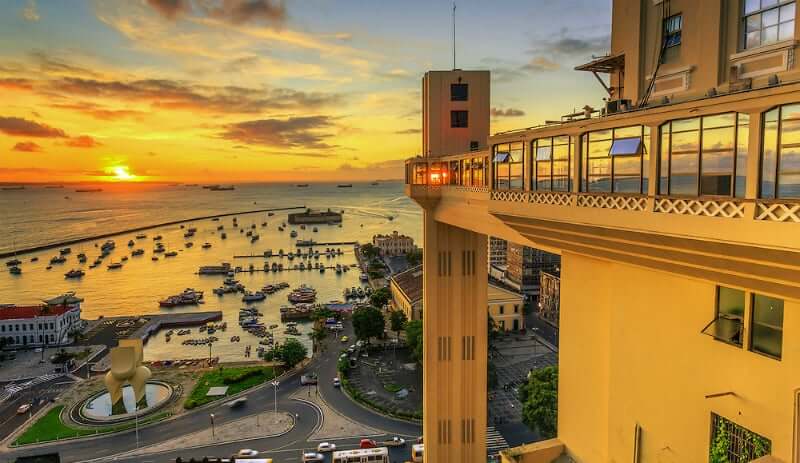Este post também está disponível em:
Português
English

The Elevador Lacerda or Lacerda Lift is one of the icons of Brazilian architecture.
The construction is a means of public transport that connects two parts of the historical centre of Salvador: the Upper and Lower Towns. At 63 metres high, it connects the two points in a quick 20-second ride.
This postcard of the Bahian capital was created to solve a major problem at a time when the city was being built and developing economically.
Salvador is divided by a large escarpment, a geological accident that creates an unevenness of almost 60 metres in height in the terrain, so transiting with goods or even walking from Upper City to the Lower City was a real challenge.
In the 17th century, the solutions found to this problem were cranes and other transport systems, but always with a focus on the transit of goods.
For people who wanted to move between the Upper Town and the Lower Town, the options were long staircases, poorly paved slopes and, in the 18th century, animal-drawn trams.
Video of the History of the Lacerda Elevator

História do Elevador Lacerda - Salvador BA
The construction of the Lacerda Elevator
Until, at the end of the 1860s, the Bahian Antônio de Lacerda took the lead in the endeavour we know today as the Lacerda Elevator.
The construction was a family endeavour. The businessman Antônio de Lacerda, who at the time was in charge of the Companhia de Transportes Urbanos, idealised the project and carried it out with the help of his younger brother, the engineer Augusto Frederico de Lacerda. Their father, Antônio Francisco de Lacerda, financed the construction.
The hydraulic lift, which took four years to build, was powered by a steam engine and had only one tower with two cabins.
To build the tower, a vertical tunnel had to be opened, so that the tower penetrated a living rock, on which the Upper Town stands. In addition, another tunnel was opened horizontally, to allow users access to the lift.
Inauguration of the Lacerda Elevator
The Hydraulic Elevator of Conceição da Praia, as it was baptised at the time, was inaugurated in 1873, becoming the main means of transport between the Cidade Alta and the Cidade Baixa. It was nicknamed “Parafuso” because of the large spiral piece that propelled the lift’s two cabins.

In this first structure, to ensure that the maximum safety limit was respected, the people to be transported were weighed individually and their weights were added together afterwards. About 20 people could be transported at a time.
The construction was a landmark of innovation at the time. In 1896, it was renamed Elevador Antônio de Lacerda, in honour of its creator, by indication of the Geographical and Historical Institute of Bahia.
Architecture and Engineering of the Lacerda Elevator
Despite all the innovation, the Lacerda Elevator was criticised at the time, especially by foreigners. They pointed out that the work used little iron, a symbol of the development of engineering and architecture of that time.
The predominant style in the architecture of the Lacerda Elevator is neoclassical, with full arch openings marking the access to the equipment in the Upper City, where the upper end of the tower was connected to the Palace Square by a metal walkway.
Refurbishments to the Lacerda Elevator
The lift went through a series of renovations until it reached the current model. In 1906, it received the first renovation to have its base widened and to be powered by electricity.

In 1930, the lift gained a second tower, two more cabins and a steel and concrete walkway that connects all the structures. In addition, the architectural complex gained elements of the art deco style, such as pilasters and thin spans in the towers.
In this renovation, which is the most striking of the development, the Lacerda Elevator reached 72 metres in height and now has a span of 71 metres on the walkway.

In addition, the lift had a greater transport capacity: from 32 to 128 people in a single journey. The interior was also modernised with granite floors and walls and electronic turnstiles.
Tourism Guide to Salvador, Bahia and the Northeast



















